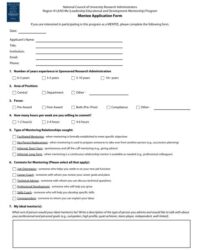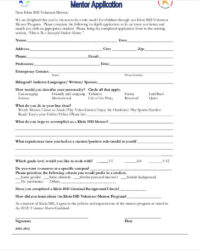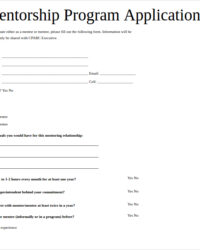Standardized forms streamline the application process, ensuring consistency and fairness. They provide a clear structure for applicants to articulate their aspirations, enabling a more thorough understanding of their needs and potential. Furthermore, these organized submissions allow mentors to quickly identify candidates who align with their expertise and mentoring style, ultimately fostering more successful mentoring relationships.
This resource explores the key components of effective frameworks for mentorship program applications, offering guidance to both applicants and program administrators. It examines best practices for development and utilization, highlighting strategies to maximize the effectiveness of the application process and ensure successful mentor-mentee pairings.
Key Components of a Mentee Application Framework
Effective application frameworks typically include several key components to ensure a thorough and informative submission. These components allow potential mentees to showcase their qualifications and aspirations, while providing valuable insights for program administrators and mentors.
1. Personal Information: Basic contact information, including name, email address, and phone number are essential for communication and follow-up. Current professional role and organization provide context for mentorship goals.
2. Background and Experience: Relevant experience, skills, and educational background offer insight into the applicant’s existing knowledge and areas of expertise. This information helps determine suitability for specific mentoring programs or mentors.
3. Career Goals and Aspirations: Clearly defined short-term and long-term career goals help mentors understand the mentee’s desired trajectory and tailor guidance accordingly. This section clarifies the applicant’s motivation for seeking mentorship.
4. Areas of Interest for Mentorship: Specific areas where the applicant seeks guidance and support, whether skill development, career advancement, or networking, allow for a more targeted and productive mentoring relationship.
5. Mentorship Expectations: Understanding the applicant’s expectations for the frequency of meetings, communication methods, and overall commitment level facilitates realistic goal setting and fosters a mutually beneficial partnership.
6. Mentor Preferences (Optional): While not always required, allowing applicants to express preferences for mentor characteristics, such as industry experience or specific skill sets, can aid in matching compatibility and maximizing the effectiveness of the mentorship.
By incorporating these elements, application frameworks provide a structured approach to gathering essential information, ensuring both mentors and mentees embark on the relationship with clarity and shared understanding, thereby increasing the likelihood of a successful outcome.
How to Create a Mentee Program Application Template
Developing a well-structured application template is crucial for attracting qualified candidates and facilitating successful mentor-mentee pairings. A thoughtful approach to design ensures relevant information is gathered efficiently, streamlining the selection process.
1. Define Program Objectives: Clearly articulate the program’s goals and target audience. This clarifies the specific skills, experience, and aspirations sought in mentees.
2. Determine Essential Information: Identify the key data points required from applicants to assess suitability and facilitate matching. Consider the program’s focus and the needs of potential mentors.
3. Structure the Template: Organize the template logically, grouping related questions for clarity and ease of completion. Ensure clear instructions and concise wording are used throughout.
4. Incorporate Relevant Sections: Include sections for personal information, background experience, career goals, mentorship expectations, and areas of interest for mentorship. Optional sections might include mentor preferences or essay questions.
5. Pilot Test the Template: Distribute the draft template to a small group for feedback on clarity, completeness, and user-friendliness. Revise based on feedback received.
6. Select an Accessible Format: Choose a format that is easily accessible and editable, such as a web-based form or a downloadable document. Consider compatibility with different devices and software.
7. Establish a Submission Process: Clearly communicate how and where applicants should submit completed templates. Provide deadlines and contact information for inquiries.
A well-designed template serves as the foundation of a successful mentorship program, effectively capturing relevant applicant information and enabling informed decision-making by program administrators and mentors. Consistent implementation ensures a fair and streamlined process for all participants.
Effective mentorship programs rely on robust application processes. Well-designed frameworks, encompassing key information about applicant backgrounds, goals, and expectations, provide essential data for participant matching and program administration. Standardized templates ensure fairness, efficiency, and a clear understanding of the mentorship opportunity for all involved. By facilitating a structured approach to information gathering, these resources contribute significantly to building successful mentoring relationships.
Careful consideration of program objectives, essential information requirements, and user experience is crucial in developing application templates. Piloting and refining these frameworks ensures clarity, accessibility, and a positive application experience. Ultimately, the quality of these tools directly impacts the overall success of the mentorship program, influencing the potential for growth and development among both mentors and mentees.


